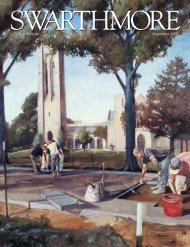A Walk in the Woods
Swarthmore College Bulletin (March 2001) - ITS
Swarthmore College Bulletin (March 2001) - ITS
You also want an ePaper? Increase the reach of your titles
YUMPU automatically turns print PDFs into web optimized ePapers that Google loves.
paved walkways, park<strong>in</strong>g lots, and impervious roofs send watersluic<strong>in</strong>g down <strong>the</strong> steep hill, goug<strong>in</strong>g <strong>the</strong> trails, and cutt<strong>in</strong>g gullies.And that, Claire po<strong>in</strong>ts out, started <strong>in</strong> 1988. Now, <strong>the</strong>re’s even morecampus development to shed water.Arboretum volunteers and College grounds crews have beenfight<strong>in</strong>g <strong>the</strong>se trends. Roger po<strong>in</strong>ts along <strong>the</strong> high edge of <strong>the</strong> slopeto beams staked as check dams, and more beams lie across <strong>the</strong> trailsas speed bumps and diverters for <strong>the</strong> runoff.He pauses to nudge a beam that has slippedaskew, and I see a m<strong>in</strong>irav<strong>in</strong>e, a few <strong>in</strong>chesdeep, snak<strong>in</strong>g around <strong>the</strong> beam’s edge. Soilsav<strong>in</strong>g on such a steep hillside demandsconstant vigilance.As we follow <strong>the</strong> path beh<strong>in</strong>d LangMusic Build<strong>in</strong>g, we come to a megarav<strong>in</strong>e.If I clambered down its muddy sides,squeez<strong>in</strong>g among <strong>the</strong> tree limb and brusherosion barriers that crews have built, Iwould disappear below ground level. I’m notexactly a tower<strong>in</strong>g hulk, but an erosion gullydeep enough to swallow even a nonhulkseems too deep to me. As for power ofrunoff, I’m now conv<strong>in</strong>ced.Work<strong>in</strong>g our way down to <strong>the</strong> water, we f<strong>in</strong>d a good illustrationof ano<strong>the</strong>r menace to <strong>the</strong> Crum: aliens.Roger gestures westward across <strong>the</strong> creek to ano<strong>the</strong>r of hisprime pedagogical spots. He has led students to this groveof trees and po<strong>in</strong>ts out <strong>the</strong>re’s basically onespecies. No o<strong>the</strong>r trees m<strong>in</strong>gle, and virtuallynoth<strong>in</strong>g grows underneath. What causesthis distribution? Roger asks <strong>the</strong> students.“The students guess that it’ssometh<strong>in</strong>g like a toxic waste dump,”he says. Rarely does someone figureout we’re stand<strong>in</strong>g among botanicalbullies. The trees, Norway maples,are spread<strong>in</strong>g throughout NorthAmerica, crowd<strong>in</strong>g out o<strong>the</strong>r specieswith <strong>the</strong> ruthlessness of a sci-fi alien<strong>in</strong>vasion. And no, Roger says, no one hasdemonstrated how Norway maples manageto do this, though his students havedone some great projects test<strong>in</strong>g ideas suchas killer shade.Claire also worries about <strong>in</strong>vasive species.She’s organized a SWAT team of volunteers whowork <strong>the</strong>ir way through key parts of <strong>the</strong> Crumdur<strong>in</strong>g w<strong>in</strong>ter, wrestl<strong>in</strong>g out Norway maples.To appreciate <strong>the</strong> volunteers’progress as wellas <strong>the</strong> challenge <strong>the</strong>yface, Claire adviseswalk<strong>in</strong>g down to <strong>the</strong>Crum’s edge <strong>in</strong> fall.There’s a lot of nostalgiaand affection for <strong>the</strong>sewoods. But <strong>the</strong>re’s also<strong>the</strong> attitude that we havemore urgent problems,and <strong>the</strong> Crum cantake care of itself.Native maples flare bright yellow early <strong>in</strong> <strong>the</strong> season, but Norway’sstay green for weeks longer. The near side of <strong>the</strong> Crum with most of<strong>the</strong> College build<strong>in</strong>gs, where crews have labored for several years,looks calendar fall-colorful. The far side, however, sports so manystill-green Norway maples, it could be a woodland <strong>in</strong> a differentseason.Norway maples top Roger’s list of most alarm<strong>in</strong>g aliens, but headds o<strong>the</strong>rs (see “Threats to <strong>the</strong> Crum,”page 23). Already, <strong>the</strong>se as well as less virulenttakeover artists have, to some degree,<strong>in</strong>filtrated about half <strong>the</strong> woodland acreage,he warns. Instead of <strong>the</strong> rich mosaic of plantcommunities now patchworked over <strong>the</strong>landscape, <strong>the</strong> woods could end up dom<strong>in</strong>atedby fewer species or, to use Roger’s words,“simplified and impoverished.”Roger has led <strong>the</strong> way <strong>in</strong>to CrumMeadow, and, after so much talk aboutmenaces to <strong>the</strong> Crum, it’s a pleasure to hearwhat treasures rema<strong>in</strong>. Roger gestures across<strong>the</strong> water toward roughly four acres he callsTrillium Slope. Alien species are creep<strong>in</strong>g <strong>in</strong>,but <strong>the</strong> slope still offers a glimpse of whatpre-European woodland probably looked like <strong>in</strong> sou<strong>the</strong>asternPennsylvania. In spr<strong>in</strong>g, before <strong>the</strong> trees leaf out, native wildflowersburst out to take advantage of <strong>the</strong>ir few weeks of full sun, anddozens of trilliums dot <strong>the</strong> slope. Of greateco-historical value it may be, but it alsosounds lovely.He gestures toward o<strong>the</strong>rgreat spots to show to students,<strong>in</strong>clud<strong>in</strong>g a realAmerican chestnut on <strong>the</strong> farside of <strong>the</strong> creek. It’s asprout of one of <strong>the</strong>giants that perishedwhen a blight sweptthrough <strong>the</strong> country earlierthis century, and <strong>the</strong>sprout’s prognosis doesnot look promis<strong>in</strong>g. Fewpeople still alive have had achance to meet a liv<strong>in</strong>g chestnut tree, evena doomed one.We stroll by <strong>the</strong> Scott Arboretum’s array of some300 hollies, which Claire has called “one of <strong>the</strong> arboretum’smost significant collections.” I still hear debate among alumniabout <strong>the</strong> location, but <strong>the</strong> trees certa<strong>in</strong>ly look fat,flossy, and happy to be <strong>the</strong>re. Then we follow apath roughly parallel to <strong>the</strong> creek, toward one of<strong>the</strong> wild spots that Roger has put on his gemslist, <strong>the</strong> marshy hollow that had anear-miss with a bridgebuilder’sback hoe.Out here on a sunnyM A R C H 2 0 0 119
















